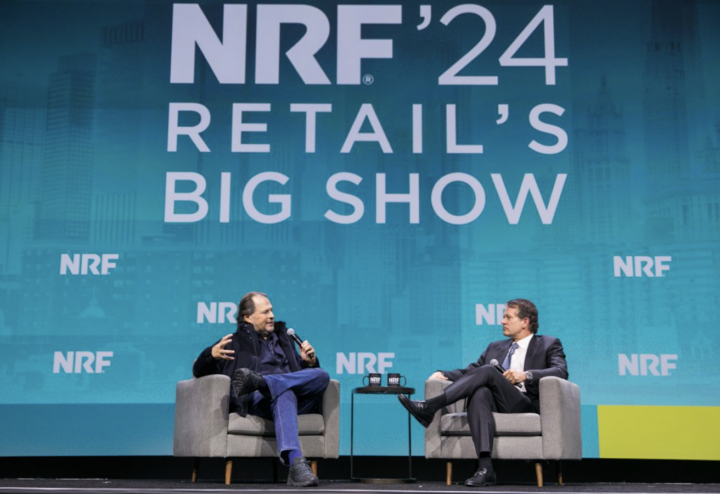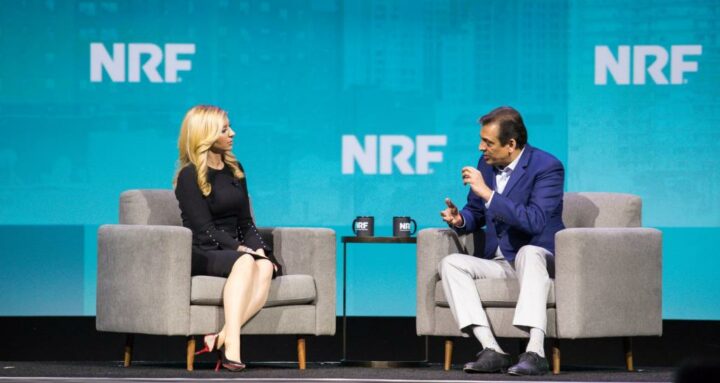Well, it’s been a hectic few weeks with CES and the NRF Big Show wrapped and it’s only the middle of January!
In case you missed it, there were over 170 sessions in the three days which wrapped up on the 16th January. The NRF Big Show is the largest retail focused event in January and as such, acts as a weather vane for the year ahead. It sets the agenda, underscoring what type of technology will be critical to the retail industry, what happened in the last quarter of 2023 and what trends are expected in retail across tech, customer experience, supply chain and more.

Every year, thousands of retail leaders get together for three full days of learning, networking, deal making and well, some laughs too! This year, the NRF expected well over 40,000 delegates at the show representing more than 6,000 brands and over 1,000 exhibitors. What we saw was a return to greatness that we experienced before the pandemic. The event is influential for various reasons. It’s a chance for retailers of all kinds to come together and hear from leading industry changemakers, explore the latest innovations and build relationships that matter with decision makers. (According to NRF data from 2023, most attendees are in the category of CEO, President, Owner, SeniorDirector, and Manager. More than that, it attracts all the big hitters in the retail space.
As the NRF proclaims: The Big Show is a place to get inspired, get connected and then get to work.
The NRF Big Show in 2023 focused on the artificial intelligence boom and how it was helping retailers develop in-store customer experiences and better utilise data analytics and personalisation capabilities to drive growth. This year, it’s tagline is “Make it Matter”. We previously touched on this very topic in our blog on “Visible Insights”. It’s about looking at the data that actually means something, rather than just exists on a dashboard somewhere.
Every business wants to deploy effective consumer analytics to understand business performance and consumer behaviour. However, some fail to understand the *what* and the *why*.
This year, the Big Show doubled down on strategies that retailers can adopt to generate long term business growth, create high-quality customer experiences and streamline operations that will stave off some of the tight margins that are expected to be squeezed further in 2024.
Focus on the Customer
We discussed the need to focus on the customer in our previous post about Zappos, but it bears repeating. Retail needs to focus on customers not profits. One begets the other. In fact, it was reiterated by incoming Levi CEO, Michelle Gass who, during the keynote address, outlined five key pillars of learning: the power of branding, being hyper-focused on the consumer, brand innovation; thinking like an omnichannel retailer, and the importance of purpose and values.
Technology: Has the NRF become the CES for retail?
This year, both CES and the NRF Big Show had AI front and centre of their agenda. NRF sessions on offer ranged from generative AI to using AI to boost point-of-sale. Technology powerhouses, Google and Salesforce, even waited until the NRF Big Show to release new AI tools and research. According to a survey Google shared at the event, 81% of retail decision makers feel “urgency” to adopt generative AI. So even if the Big Show starts to look like CES, the agenda was on trend and delegates were eager to hear more!

The Elephant in the Room
Generative AI has become one of retail’s biggest buzzwords over the past year. It was addressed by the panel moderator, Amy Eschliman, as the “elephant in the room”. The topic is not new but with so many use cases out there, how does a retailer implement it in their own business? The first point that was made over and over again is this: It’s vital to tailor generative AI to your particular goals, customers and employees. Not only that, but generative AI (similarly to the cellphone when it was released), has the potential to transform retail. From amalgamating and analysing data to manipulating it faster than ever before. Walmart uses generative AI to refine the content on the Walmart website to help it rank higher in search. However, it is important to remember that generative AI is not powerful without the data it is working with. If you don’t have the data, generative AI is powerless. Data is your foundation, so ensure it’s solid. Footwear News summarised some of the use cases quite well, including in personalised discounts for customers.
Insights become Intelligence
There was a really insightful interview with FedEx CEO, Raj Subramaniam. The discussion started with some statistics about eCommerce sales. According to Subramaniam, online retail sales are expected to reach an annual total of $8 trillion by 2026, across the world’s 4 billion consumers.
You’re all here because you want to take a larger share of that $8 trillion,” he said. “You want to reach those 4 billion consumers and turn them into loyal customers. And you want to optimize your supply chain end-to-end and deliver a better, seamless ecommerce experience.

Again and again during the discussion, Subramaniam returned to the importance of data, analytics, artificial intelligence, and machine learning:
We combine the power of AI and machine learning with the capabilities of our physical network to create end-to-end digital solutions and an unparalleled experience for you and your customers. To put it simply, our mission is to make supply chains smarter for everyone.
There were some additional stand out soundbites during the discussion which we had to highlight and there is a summary from Retail Touch Points on the website:
- The FedEx mission is to make supply chains smarter for everyone.
- Physical networks get us where we need to be, but digital supply chains make that journey faster, more precise and — equally critical — more seamless. And that’s what consumers expect in this time of anytime, anywhere commerce.
- eCommerce is more than sales, it’s also demand. It’s conversion. Fulfilment. Visibility. And, of course, returns.
Adapt and Deliver – or Die
Levi’s incoming CEO mentioned it, Ed Stack, winner of the NRF Visionary Award focused on it and Ulta Beauty explained how embracing it helped catapult their business into hyper-growth! Each referred to it in different ways, but the message was this: adapt or die and make sure you’re not being left behind.
I’ll start by saying the human experience is most important for us at Ulta Beauty – CEO Dave Kimbell
Ulta has an Ulta Beauty virtual chat capability powered by AI, and elevated virtual hair try-on capabilities that tap Gen AI. This has boosted customer engagement but most of all – the whole customer experience. The rate of change in retail is only matched by the high expectations that consumers have. It’s important to get the foundations of any retail organisation right (after your product of course). But this all comes at a cost – and when selling in EU and UK markets, it can seem almost impossible to manage VAT calculations, filings, and payments in addition to being customer obsessed!

Focus on Growth
We believe every ambitious retail organisation needs a partner who can manage all the sales tax compliance matters. These are often complicated, time consuming and plain well distracting. While you focus on growth, let us focus on the “other” things!
Taxmatic automates VAT calculations, filings, and payments for eCommerce retailers selling in EU and UK markets. It integrates seamlessly with eCommerce selling platforms to access sales order data in real time. The process includes secure payments wallet technology to complete sales tax remittance and manage refunds. Our customers have the peace of mind that comes from full regulatory compliance. Plus, the benefits of eliminating manual processes. Gaining more time to expand their online business in new international markets.
